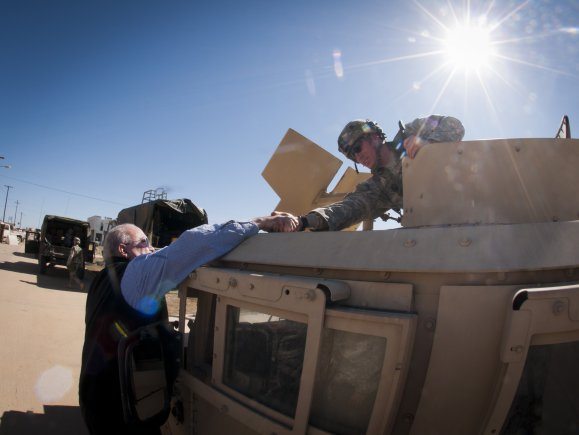Training bases like the Joint Readiness Training Center here will be central to preparing America’s Army for future conflicts that could come up at a moment’s notice, said Under Secretary of the Army Joseph W. Westphal, during a visit here, Oct. 19.
“One never knows when the president will need his Army to address an issue somewhere around the world,” Westphal said. “We need to be trained and ready at all times, and that level of training, and that level of readiness that we will have to maintain into the future will require that we have places like Fort Polk ready to help us do that. What I saw here today is that we have good footing there.”
Beginning Oct. 9, more than 4,800 Soldiers, many from the 2nd Brigade Combat Team of the 82nd Airborne Division, descended upon the training grounds at Fort Polk to participate in the Joint Readiness Training Center’s 13-01 training rotation.
Many of the participating Soldiers entered the bare, unprepared training space via parachute. The training is a departure from past rotations at the JRTC which have focused on training Soldiers for deployments to Afghanistan and Iraq through counterinsurgency-based mission readiness exercises.
The most recent rotation at the center put an emphasis on “decisive action,” which required Soldiers to exercise both wide-area security and combined arms maneuver and conduct offensive, defensive operations and stability operations.
Soldiers participating in the 13-01 rotation entered, via parachute, a location that was completely empty. They were required to secure an airstrip, bring in needed supplies and equipment via U.S. Air Force aircraft, conduct a noncombatant evacuation operation for American citizens who were already on the ground in a nearby town as part of the fictional scenario, defend their position, and then later conduct offensive operations against a “hybrid threat” that included “near-peer” forces, irregular forces, terrorist and criminal groups.
Westphal visited with the leadership of the units there to train and with the leadership of partner organizations who also participated in the exercise, including Army Special Operations Forces. He said he was “able to talk to them about the challenges they face both in the training area and integration area and get some real straightforward commentary on what we need to do at headquarters to make this continue to be a success down the road.”
As the Army’s under secretary, Westphal must stay abreast of the Army needs and work with other senior leadership to ensure continued support of the kinds of training that takes place at the JRTC.
“We need to keep an eye on the investment here and keep an eye on what is needed to make sure we sustain this kind of opportunity,” Westphal said. “Training and readiness for our force of the future is absolutely critical.”
While Westphal spoke with many of the senior leadership on the ground at JRTC, he also met with the young Soldiers and noncommissioned officers training there, and said he was impressed with their knowledge and professionalism.
“Every once in a while I’ll go up to a private, a specialist, a sergeant and start asking them about what they are doing,” he said. “I’m absolutely impressed with their intellect, their knowledge, and their easy disposition from which they are doing this. They don’t have their hair on fire — they are just professional people.”
Westphal said that the talent he saw at JRTC is critical to America’s future force, and that it must be preserved.
“What we need to do as a country is sustain that talent, and to invest in that talent, and to ensure this country’s defense will always be absolutely the very best,” he said. “It’ll be the very best, not because of the equipment we have, but because of the people that manage that equipment and operate that equipment and sustain that equipment — that’s our Soldiers, Sailors, Airmen and Marines.”










